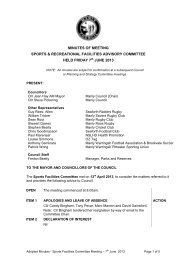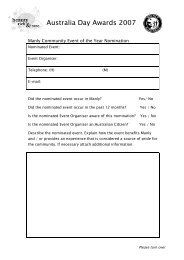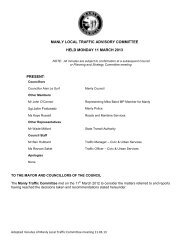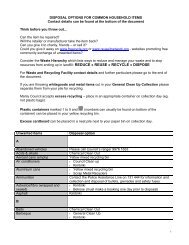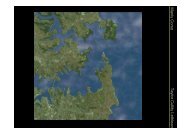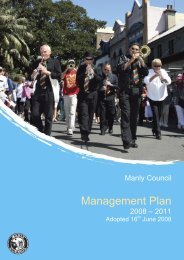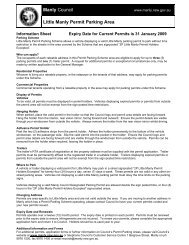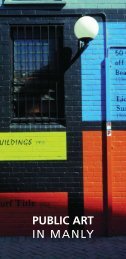Manly Lagoon Dredging Project - Manly Council - NSW Government
Manly Lagoon Dredging Project - Manly Council - NSW Government
Manly Lagoon Dredging Project - Manly Council - NSW Government
- No tags were found...
Create successful ePaper yourself
Turn your PDF publications into a flip-book with our unique Google optimized e-Paper software.
<strong>Manly</strong> <strong>Lagoon</strong> <strong>Dredging</strong> <strong>Project</strong> – Review of Environmental FactorsPrepared for <strong>Manly</strong> and Warringah <strong>Council</strong>sCyanide, styrene, naphthalene, phenolic compounds, benzene, toluene and relatedcompounds could not be detected in either treated or untreated sediments;Organochlorine and orthophosphate pesticides and PCBs could not be detected ineither treated or untreated sediments; andTPHs were detected at very low levels, which were, in total an order of magnitudebelow the guideline for use on open spaces.Acid Sulfate SoilsSediments have the potential to produce acid run off and would require a liming rateof 10 kg per tonne dry weight to neutralise acidity. It should be noted that this is alower rate than reported by Patterson Britton and Partners (Appendix E).Runoff WaterSecond flush water showed a 22% decrease in suspended solids compared to firstflush water, indicating that the geobag and ULTIMER 7757 polymer functioned asintended;Suspended solid levels of 171 mg/L in the overburden water were significantly higherthan those in the undisturbed water column, and appropriate mitigation measures,including discharge in a controlled manner within the area of the silt curtains areincluded in Section 5.3. Data on the effects of suspended sediments on estuarinefish suggest that levels greater than 600 mg/L may cause fish mortality (Wilber andClark 2001), and hence 171 mg/L of suspended solids in the overburden water isunlikely to negatively impact on estuarine fish species;The concentrations of metals did not differ significantly in the first flush compared tosecond flush samples, but were higher compared to the reference sample for allmetals (Appendix C). This indicates that sediments were significant sources of allmetals except copper, which was present in both water and sediments. Residualmetal levels exceeded ANZECC (2000) guidelines for chromium, copper, lead andzinc. However, this was also the case for some of the results obtained during waterquality monitoring in July to September 2009 at various locations within the lagoon(see Appendix H);Concentrations of Ammonia, Nitrite and Nitrate (NOx), TN and TP were similar toresults obtained during water quality monitoring in July to September 2009 at variouslocations within the lagoon (see Appendix H), however levels exceeded ANZECC(2000) guidelines for protection of aquatic ecosystems for slightly disturbedecosystems. Comparison to the reference sample indicates that sediments were asignificant source of nutrients for most nutrient parameters;Organochlorine and organophosphorous pesticides, phenols, PAHs and BTEXcompounds were not detected in either first flush or second flush water;Second flush water had 29% lower levels of enterococci bacteria compared to firstflush water, indicating that the flocculant acted to reduce enterococci that weresuspended in the dredge slurry. However, residual bacterial counts exceededguidelines for both primary and secondary contact. Results for enterococci levels in2 July 2010 Cardno (<strong>NSW</strong>/ACT) Pty Ltd 27H:\Doc\2010\Reports.2010\Rep2580v4.doc



